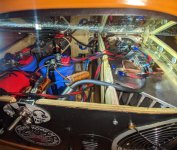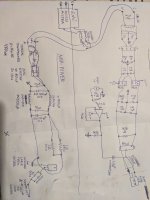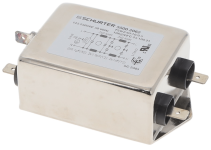Here is my diy amp, front and inside 🙂
Just resently replaced bad mosfet, and installed copper heat spreader.
Now mosfet run about 70-80° celsius.
Maybe future i change thermal paste with thermal grizzly carbonaut pads.
Under the copper plate is 3* sot 247 ceramis insulators.
Copper plate is 30*70mm and 5mm, originally used power bar for transformer or something similar electric usage.
Classical point to point wiring and crimping vs soldering here and there.
Parts are someone else made, i only but them in practical use, but i think it always be like that, when you talk about diy setup more or less 😀
What do you think of the setup?
Just resently replaced bad mosfet, and installed copper heat spreader.
Now mosfet run about 70-80° celsius.
Maybe future i change thermal paste with thermal grizzly carbonaut pads.
Under the copper plate is 3* sot 247 ceramis insulators.
Copper plate is 30*70mm and 5mm, originally used power bar for transformer or something similar electric usage.
Classical point to point wiring and crimping vs soldering here and there.
Parts are someone else made, i only but them in practical use, but i think it always be like that, when you talk about diy setup more or less 😀
What do you think of the setup?
Attachments
I think that's cool;-)
Two tips:
The material of the cabinet, in this case wood, modulates the sound. It sounds gray, flat, torn.
The screw terminals of the connections are unnecessary material transitions. And these also modulate the sound: scrap metal. These two different characters cancel each other out a little, but lead to uncleanliness and noise. In general, the materials of the electrical devices have to counteract the materials of the speakers (wood) and device basis (any wooden shelves...) and a lot of wooden interiors.
Two tips:
The material of the cabinet, in this case wood, modulates the sound. It sounds gray, flat, torn.
The screw terminals of the connections are unnecessary material transitions. And these also modulate the sound: scrap metal. These two different characters cancel each other out a little, but lead to uncleanliness and noise. In general, the materials of the electrical devices have to counteract the materials of the speakers (wood) and device basis (any wooden shelves...) and a lot of wooden interiors.
I don't know what tho think...Woody sound.
In that case i have to tell everyone that wooden box holding speaker elements inside sound way too much woody.
Maybe make speaker capinet with cast iron, i think then atleast metal music blow my socks off If nothing else make it 😀
In that case i have to tell everyone that wooden box holding speaker elements inside sound way too much woody.
Maybe make speaker capinet with cast iron, i think then atleast metal music blow my socks off If nothing else make it 😀
There are also aluminum, stone, concrete, some plastics and others from which speakers enclosures are made. The developers and manufacturers often justify this choice of material;-)
Nice setup. Wooden box is fine if you check the temp.
Metal could be good to shield from electromagnetic interference if you operate heavy machinery close by.
My first teenager amp had a carton chassis and sounded really good until it caught fire in my room. I got grounded for a while.
Metal could be good to shield from electromagnetic interference if you operate heavy machinery close by.
My first teenager amp had a carton chassis and sounded really good until it caught fire in my room. I got grounded for a while.
Heatsink is under 60 celsius maybe 50-55.
Rest Components are somethink between 30-45 so average i think im safe side.
And If something get shorted well, my amp operate nominal almoust shorted already, so not mutch going to change 😀
Constant 14 Ampere running throw paraller resistors(2*1ohm) and mosfet.
And then there is ofcourse fuse where mains coming in.
And there is two fans operated constant when device is on and If one or both fails it is noticable very soon and there is still time to shut down device.
Rest Components are somethink between 30-45 so average i think im safe side.
And If something get shorted well, my amp operate nominal almoust shorted already, so not mutch going to change 😀
Constant 14 Ampere running throw paraller resistors(2*1ohm) and mosfet.
And then there is ofcourse fuse where mains coming in.
And there is two fans operated constant when device is on and If one or both fails it is noticable very soon and there is still time to shut down device.
I've built a couple amps in wood cases, including a tube amp. I treated the boxes with No-Burn. Years later, after dismantling one, I tried to set it on fire with a MAP gas torch. It would not ignite, it only charred where the flame had been.Nice setup. Wooden box is fine if you check the temp.
Thanks for sharing. Love mad projects.
A few questions:
Do you really need an inductor at output?
What is the purpose of the 1k resistor loading the opamp output?
Have you tried listening without that line filter?
You have the easy option to delegate the voltage gain to the opamp and turn the fet into a follower. Have you tried it?
A few questions:
Do you really need an inductor at output?
What is the purpose of the 1k resistor loading the opamp output?
Have you tried listening without that line filter?
You have the easy option to delegate the voltage gain to the opamp and turn the fet into a follower. Have you tried it?
Im not sure is inductor really necessary speaker output, but when i earlier installed it, it make amplifier more responsive and cleaner linearity for sound output. It's made litz wire around plastic tube about 20 turns.
1k resistor is supporting same linearity, because otherwise burson vivid V6 sees only capasite fet load and with resistor involve it make situation also resistive too.
When i installed it, it make same effect, better signal handling with good sound output for speakers.
Maybe follower is possible, but now i enjoy it like it is.
Bias voltage for output sits about 7.5v and when swing is maximum it drops about 800mv becouse inside and outside stucture won't let go past that. (500mohm vs 32mohm) and other side it is about 14.3v so pp is about same and linear.
1k resistor is supporting same linearity, because otherwise burson vivid V6 sees only capasite fet load and with resistor involve it make situation also resistive too.
When i installed it, it make same effect, better signal handling with good sound output for speakers.
Maybe follower is possible, but now i enjoy it like it is.
Bias voltage for output sits about 7.5v and when swing is maximum it drops about 800mv becouse inside and outside stucture won't let go past that. (500mohm vs 32mohm) and other side it is about 14.3v so pp is about same and linear.
And 1k resistor for opamp output is more meaning now when i think of it.
When there is no signal output, 1k resistor offer ground for 6.8uF coupling capasitor and when signal is present then it act as a resistive load for opamp.
If i turn fet into a follower maybe i have to make changes that is not ideal for what i want.
For now examble there is almoust nothing feedback and that is amazing alone. 🙂
When there is no signal output, 1k resistor offer ground for 6.8uF coupling capasitor and when signal is present then it act as a resistive load for opamp.
If i turn fet into a follower maybe i have to make changes that is not ideal for what i want.
For now examble there is almoust nothing feedback and that is amazing alone. 🙂
Last edited:
I'm also using 5mm Cu heatsink interfaces 100x150mm so good to see I'm not the only one. (Aleph JZM)Here is my diy amp, front and inside 🙂
Just resently replaced bad mosfet, and installed copper heat spreader.
Now mosfet run about 70-80° celsius.
Maybe future i change thermal paste with thermal grizzly carbonaut pads.
Under the copper plate is 3* sot 247 ceramis insulators.
Copper plate is 30*70mm and 5mm, originally used power bar for transformer or something similar electric usage.
Classical point to point wiring and crimping vs soldering here and there.
Parts are someone else made, i only but them in practical use, but i think it always be like that, when you talk about diy setup more or less 😀
What do you think of the setup?
And using amp without mains ac filter isn't problem, however when there was connected same breaker box line a washing machine and or dishwasher, sometimes motor indused elektrick spikes or some electric interferens coming throw amp and make speakers produse some pops or other sounds with the machine on the line momentarily.Thanks for sharing. Love mad projects.
A few questions:
Do you really need an inductor at output?
What is the purpose of the 1k resistor loading the opamp output?
Have you tried listening without that line filter?
You have the easy option to delegate the voltage gain to the opamp and turn the fet into a follower. Have you tried it?
So adding filter make that problem dissappierd and im happy with that mod.
Great that it works for you. Cause in the absence of obvious interference i really hate what these filters do to the sound.
More i think what possible NTC resistor make If it not bypassed after startup.
I don't have that system installed, but maybe i should have, because fuse is now ceramic slow 6A rated what is only one to handle inrush current and stay alive long time.
Maybe one day i find good scematic and get to assembly it of my system or already madeone and install it.
Can you give some information, how does that type filter affect sound produce for amp usage?
Maybe it is more affecting when using AB or other type amplifier, where dynamic change is more involve when output voltage and current for speakers are demanded.
I don't have that system installed, but maybe i should have, because fuse is now ceramic slow 6A rated what is only one to handle inrush current and stay alive long time.
Maybe one day i find good scematic and get to assembly it of my system or already madeone and install it.
Can you give some information, how does that type filter affect sound produce for amp usage?
Maybe it is more affecting when using AB or other type amplifier, where dynamic change is more involve when output voltage and current for speakers are demanded.
I thought of sound waves propagating through the air tubes fitted on the PCB, some of them are leaky and allow sound outside the PCB contained by the wood of the case.I don't know what tho think...Woody sound.
In that case i have to tell everyone that wooden box holding speaker elements inside sound way too much woody.
Maybe make speaker capinet with cast iron, i think then atleast metal music blow my socks off If nothing else make it 😀
- Home
- Amplifiers
- Solid State
- Class A SE amplifier



